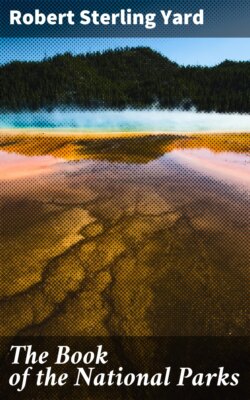Читать книгу The Book of the National Parks - Robert Sterling Yard - Страница 13
На сайте Литреса книга снята с продажи.
III
ОглавлениеThe Pacific Coast Expositions of 1915 marked the beginning of the nation's acquaintance with its national parks. In fact, they were the occasion, if not the cause, of the movement for national parks development which found so quickly a country-wide response, and which is destined to results of large importance to individual and nation alike. Because thousands of those whom the expositions were expected to draw westward would avail of the opportunity to visit national parks, Secretary Lane, to whom the national parks suggested neglected opportunity requiring business experience to develop, induced Stephen T. Mather, a Chicago business man with mountain-top enthusiasms, to undertake their preparation for the unaccustomed throngs. Mr. Mather's vision embraced a correlated system of superlative scenic areas which should become the familiar playgrounds of the whole American people, a system which, if organized and administered with the efficiency of a great business, should even become, in time, the rendezvous of the sightseers of the world. He foresaw in the national parks a new and great national economic asset.
The educational and other propaganda by which this movement was presented to the people, which the writer had the honor to plan and execute, won rapidly the wide support of the public. To me the national parks appealed powerfully as the potential museums and classrooms for the popular study of the natural forces which made, and still are making, America, and of American fauna and flora. Here were set forth, in fascinating picture and lines so plain that none could fail to read and understand, the essentials of sciences whose real charm our rapid educational methods impart to few. This book is the logical outgrowth of a close study of the national parks, beginning with the inception of the new movement, from this point of view.
How free from the partisan considerations common in governmental organization was the birth of the movement is shown by an incident of Mr. Mather's inauguration into his assistant secretaryship. Secretary Lane had seen him at his desk and had started back to his own room. But he returned, looked in at the door, and asked:
Copyright by Haynes, St. Paul
THE GIANT GEYSER—GREATEST IN THE WORLD
Yellowstone National Park
"Oh, by the way, Steve, what are your politics?"
This book considers our national parks as they line up four years after the beginning of this movement. It shows them well started upon the long road to realization, with Congress, Government, and the people united toward a common end, with the schools and the universities interested, and, for the first time, with the railroads, the concessioners, the motoring interests, and many of the public-spirited educational and outdoor associations all pulling together under the inspiration of a recognized common motive.
Of course this triumph of organization, for it is no less, could not have been accomplished nearly so quickly without the assistance of the closing of Europe by the great war. Previous to 1915, Americans had been spending $300,000,000 a year in European travel. Nor could it have been accomplished at all if investigation and comparison had not shown that our national parks excel in supreme scenic quality and variety the combined scenery which is comfortably accessible in all the rest of the world together.
To get the situation at the beginning of our book into full perspective, it must be recognized that, previous to the beginning of our propaganda in 1915, the national parks, as such, scarcely existed in the public consciousness. Few Americans could name more than two or three of the fourteen existing parks. The Yosemite Valley and the Yellowstone alone were generally known, but scarcely as national parks; most of the school geographies which mentioned them at all ignored their national character. The advertising folders of competing railroads were the principal sources of public knowledge, for few indeed asked for the compilation of rates and charges which the Government then sent in response to inquiries for information. The parks had practically no administration. The business necessarily connected with their upkeep and development was done by clerks as minor and troublesome details which distracted attention from more important duties; there was no one clerk whose entire concern was with the national parks. The American public still looked confidently upon the Alps as the supreme scenic area in the world, and hoped some day to see the Canadian Rockies.
